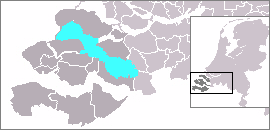|
Scheldt–Rhine Canal
The Scheldt–Rhine Canal (Schelde-Rijnkanaal) in Belgium and the Netherlands connects Antwerp with the Volkerak, and thereby the Scheldt with the Rhine. Route The canal starts close to the Scheldt river, at the port of Antwerp, and generally runs north. After it passes the Dutch-Belgian border, it serves as the border between the Dutch provinces of North Brabant and Zeeland. Just north of Zuid-Beveland ships have to pass the to enter the lower part of the canal. Just north of the sluices the canal enters the artificial and leaves this lake again as a canalised section of the former Eendracht strait, before terminating in the Volkerak estuary. Here, the provide access to the Rhine-Meuse Delta and the port of Rotterdam. History During the 1920s the Belgian government demanded a replacement for the Canal through Zuid-Beveland, to keep the port of Antwerp accessible for the lucrative Rhine trade. According to the original plan, the new canal was supposed to connect Antwe ... [...More Info...] [...Related Items...] OR: [Wikipedia] [Google] [Baidu] |
Canal Through Zuid-Beveland
The Canal through Zuid-Beveland (Dutch: ''Kanaal door Zuid-Beveland'') in the southwest Netherlands is the westernmost of two canals crossing the Zuid-Beveland peninsula. It connects the Western Scheldt near Hansweert (to the south of the canal) via a lock complex and the Eastern Scheldt (to the north) with which it has an open connection. History Planning for faster and more reliable route between the Port of Antwerp and the Rhine began with Napoleon I, but this planning was interrupted by the declaration of the Kingdom of the Netherlands in 1815, and by the Belgian Revolution in 1830, issues which took precedence over the development of a new waterwater. With the Treat of London in 1839, which recognized the independence of Belgium, provisions were included that dealt with cooperation between the Netherlands and Belgium concerning how shipping between Antwerp and the Rhine would be handled; the Netherlands was obligated to keep a connection open between the two. The plann ... [...More Info...] [...Related Items...] OR: [Wikipedia] [Google] [Baidu] |
Canals Opened In 1975
Canals or artificial waterways are waterways or river engineering, engineered channel (geography), channels built for drainage management (e.g. flood control and irrigation) or for conveyancing water transport watercraft, vehicles (e.g. water taxi). They carry free, calm surface flow under atmospheric pressure, and can be thought of as artificial rivers. In most cases, a canal has a series of dams and lock (water transport), locks that create reservoirs of low speed current flow. These reservoirs are referred to as ''slack water levels'', often just called ''levels''. A canal can be called a navigation canal when it parallels a natural river and shares part of the latter's discharge (hydrology), discharges and drainage basin, and leverages its resources by building dams and locks to increase and lengthen its stretches of slack water levels while staying in its valley. A canal can cut across a drainage divide atop a ridge, generally requiring an external water source abo ... [...More Info...] [...Related Items...] OR: [Wikipedia] [Google] [Baidu] |
International Canals
International is an adjective (also used as a noun) meaning "between nations". International may also refer to: Music Albums * ''International'' (Kevin Michael album), 2011 * ''International'' (New Order album), 2002 * ''International'' (The Three Degrees album), 1975 *''International'', 2018 album by L'Algérino Songs * The Internationale, the left-wing anthem * "International" (Chase & Status song), 2014 * "International", by Adventures in Stereo from ''Monomania'', 2000 * "International", by Brass Construction from ''Renegades'', 1984 * "International", by Thomas Leer from ''The Scale of Ten'', 1985 * "International", by Kevin Michael from ''International'' (Kevin Michael album), 2011 * "International", by McGuinness Flint from ''McGuinness Flint'', 1970 * "International", by Orchestral Manoeuvres in the Dark from '' Dazzle Ships'', 1983 * "International (Serious)", by Estelle from '' All of Me'', 2012 Politics * Internationalism (politics) * Political international, an ... [...More Info...] [...Related Items...] OR: [Wikipedia] [Google] [Baidu] |
Tholen
Tholen () is a 25,000 people municipality in the southwest of the Netherlands. The municipality of Tholen takes its name from the town of Tholen, which is the largest population center in the municipality. The municipality consists of two peninsulas, formerly islands, the larger one on the south also called Tholen, the smaller one on the north called Sint Philipsland. The two are separated by the former strait, now bay, of Krabbenkreek. The municipality is bordered on the east by the Eendracht, once a Scheldt branch but now part of the Scheldt-Rhine Canal, crossed by three road bridges, by the Oosterschelde estuary to the south, the straits of Keeten- Mastgat to the west and the Krammer strait to the north. The town has a small historical center partly surrounded by a " gracht" and partly bordered by a harbour for fishing boats and yachts. Population centers On the island Sint Philipsland there are three villages: On the island Tholen there are seven population cente ... [...More Info...] [...Related Items...] OR: [Wikipedia] [Google] [Baidu] |
Bergen Op Zoom
Bergen op Zoom (; called ''Berrege'' in the Brabantian dialect, local dialect) is a List of cities in the Netherlands by province, city and Municipalities of the Netherlands, municipality in southwestern Netherlands. It is located in the Provinces of the Netherlands, province of North Brabant, at the provincial border with Zeeland. In 2025, the municipality had a population of 70,216. Etymology The city was built on a site where two types of soil meet: sandy soil and marine clay. The sandy soil pushed against the marine clay, accumulating and forming hills over several centuries. People called those hills the ''Brabantse Wal'', literally meaning "ramparts of Brabant". ''Zoom'' refers to the border of these ramparts and ''bergen'' in Dutch means mountains or hills. The name has nothing to do with the little channel, the Zoom, which was later built through Bergen op Zoom. History Bergen op Zoom was granted City rights in the Low Countries, city status probably in 1212. In 128 ... [...More Info...] [...Related Items...] OR: [Wikipedia] [Google] [Baidu] |
Reimerswaal (municipality)
Reimerswaal () is a municipality in the province of Zeeland in the southwestern Netherlands on Zuid-Beveland, named after the lost city. The municipality had a population of in , and has a surface area of of which is water. The central town Yerseke is known for trade in mussels and oysters. Kruiningen is known for the former ferry from Kruiningen to Perkpolder which was in service up to 2003. The municipality of Reimerswaal was established in 1970, from the aggregation of the municipalities Krabbendijke, Kruiningen, Rilland-Bath, Waarde, and Yerseke. The municipal coat of arms( nl) dates to 1970. The sword in a red field is derived from the coat of arms of the lost city of Reimerswaal in use in the 15th century ( Beyeren Armorialbr>p. 107 of ''gules two swords inverted saltirewise argent and or''. In addition, the municipal coat of arms shows the comital arms of Wittelsbach-Hainaut in chief. Population centers Topography ''Dutch Topographic map of the municipal ... [...More Info...] [...Related Items...] OR: [Wikipedia] [Google] [Baidu] |
Philipsdam
The is a compartmentalisation dam constructed as part of the Delta Works in the Netherlands. It separates water of the lakes Krammer (Netherlands), Krammer and Volkerak from the Oosterschelde, and connects the Grevelingendam to Sint Philipsland (island), Sint Philipsland. History, design, and construction Design and optioneering The need for the dam In 1974, it was decided by Rijkswaterstaat and the Den Uyl cabinet to construct the Oosterscheldekering as a storm surge barrier at the mouth of the Oosterschelde, instead of completely Closure of tidal inlets, closing off the tidal inlet at that location. The construction of the Oosterscheldekering required the compartmentalisation of the basin. The compartmentalisation model chosen involved the construction of the Philipsdam, the Oesterdam, and a discharge channel for managing the level and quality of the lake that would then form behind the dams. The overall project was also required to create a freshwater lake for water ... [...More Info...] [...Related Items...] OR: [Wikipedia] [Google] [Baidu] |
Oesterdam
The ( English: ''Oyster Dam'') is a compartmentalisation dam in The Netherlands, situated between Tholen and South Beveland in the eastern part of the Eastern Scheldt. The dam, with a length of 10.5 kilometres, is the longest structure built for the Delta Works. The Oesterdam was necessitated, like the Philipsdam, after the decision was taken to close off the Eastern Scheldt with a storm surge barrier, rather than a solid dam. For navigation of recreational boats and fishing vessels between the Scheldt–Rhine Canal and the Eastern Scheldt, the dam contains a small lock near its northern end, the . Located adjacent to the dam near its southern end are a pair of large locks, the , constructed to separate the canal's brackish water to the south from the freshwater to the north. Design background The Oesterdam was not originally part of the planned Delta Works, but rather is one of the compartmentalisation dams which became necessary when it was decided not to close off the ... [...More Info...] [...Related Items...] OR: [Wikipedia] [Google] [Baidu] |
Oosterschelde
The Eastern Scheldt () is a former estuary in the province of Zeeland, Netherlands, between Schouwen-Duiveland and Tholen on the north and Noord-Beveland and Zuid-Beveland on the south. It also features the largest Oosterschelde National Park, national park in the Netherlands, founded in 2002. History During the Roman Era it was the major mouth of the Scheldt River. Before the St. Felix's Flood of 1530, it flowed north as a river from the east end of the Westerschelde, turned west a little west of Bergen op Zoom, and then west along the north edge of what is now the Verdronken Land van Reimerswaal, and after that widened into an estuary. Parts of that lost land were later reclaimed, restricting part of the connection to the Scheldt River to a narrow channel called the Kreekrak, which silted up and became unnavigable. In 1867 the Kreekrak was closed off with a railway Embankment (transportation), embankment, connecting in the process the island of Zuid-Beveland to the mainla ... [...More Info...] [...Related Items...] OR: [Wikipedia] [Google] [Baidu] |
Striene
De Striene was a water channel that ran between the Schelde near Tholen and the Meuse (river), Maas rivers in Zeeland in the Netherlands. In the St. Elizabeth's flood (1421), St. Elizabeth's Flood of 1421 the watercourses in the Maas and Rhine delta were drastically changed, and the Striene disappeared. However, the current Scheldt-Rhine Canal mostly follows the ancient path of the Striene. The place names Strijen, Cromstrijen, and Strijenham on Tholen are probably derived from ''Striene''. The name Strienestad used for Steenbergen in North Brabant during the Carnival, also refers to the Striene. References History of South Holland History of Zeeland Tholen Former rivers {{Zeeland-geo-stub ... [...More Info...] [...Related Items...] OR: [Wikipedia] [Google] [Baidu] |
Delta Works
The Delta Works () is a series of construction projects in the southwest of the Netherlands to protect a large area of land around the Rhine–Meuse–Scheldt delta from the sea. Constructed between 1954 and 1997, the works consist of dams, sluices, Lock (water transport), locks, Levee, dykes, levees, and floodgate, storm surge barriers located in the provinces of the Netherlands, provinces of South Holland and Zeeland. The aim of the dams, sluices, and storm surge barriers was to shorten the Dutch coastline, thus reducing the number of dikes that had to be raised. Along with the Zuiderzee Works, the Delta Works have been declared one of the Seven Wonders of the Modern World by the American Society of Civil Engineers. History Due to indecision and the World War II, Second World War, little action was taken. In 1950 two small estuary mouths, the Brielse Gat near Brielle and the Botlek near Vlaardingen were dammed. After the North Sea flood of 1953, a Delta Works Commission w ... [...More Info...] [...Related Items...] OR: [Wikipedia] [Google] [Baidu] |






